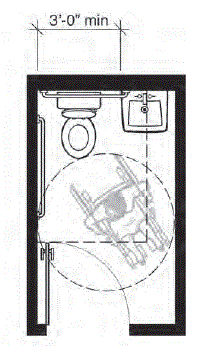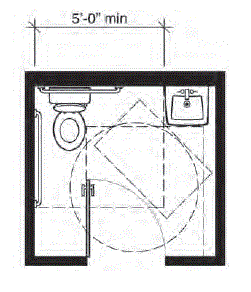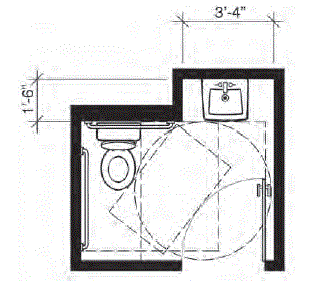Comparison of Single-User Toilet Room Layouts: 2A, 2B, and 2C
|
1991 Standards  Plan-2A: 1991 Standards Minimum with In-Swinging Door 5’-0" x 8’-6" • 42.50 Square Feet |
| This plan shows a typical example of a single-user toilet room that meets the minimum requirements of the 1991 Standards. Depending on the width of the hallway and other circulation issues, it can be preferable to swing the entry door into the toilet room. Businesses and public entities typically prefer to have an in-swinging door. The in-swinging door increases overall room size because it cannot swing over the required clear floor space at any accessible fixture, (see section 4.22.2 of the 1991 Standards). This increases the room depth from Plan−1A. The door is permitted to swing over the required turning space shown as a 60-inch circle. |
|
2010 Standards  Plan-2B: 2010 Standards Minimum with In-Swinging Door 7’-0" x 6’-6" • 45.50 Square Feet |
|
This plan shows a typical example of a single-user toilet room that meets the minimum requirements of the 2010 Standards when the entry door swings into the room. In the 2010 Standards an exception allows the entry door to swing over the clear floor spaces and clearances required at the fixtures if a clear floor space complying with section 305.3 (minimum 30 inches by 48 inches) is provided outside the arc of the door swing, section 603.3.3 exception 2. The required maneuvering space for the door, section 404.2.4.1 and Figure 404.2.4.1(a), also is a factor in room size. This clear space cannot be obstructed by the plumbing fixtures. Note that this layout provides more space for turning when the door is closed than Plan−1B. This layout is seven percent (7%) larger than the accompanying Plan−2A: 1991 Standards Minimum with In-Swinging Door example. |
|
2010 Standards  Plan-2C: 2010 Standards Minimum with In-Swinging Door 7’-0" x 6’-6" • 40.00 Square Feet (plumbing chase not included) |
|
This plan shows the same typical features of a single-user toilet room that meets the minimum requirements of the 2010 Standards as Plan−2B when the entry door swings into the room. Note that this layout also provides more space for turning when the door is closed than Plan−1B. This layout is six point two five percent (6.25%) smaller than the accompanying Plan−2A: 1991 Standards Minimum with In-Swinging Door example. |

User Comments/Questions
Add Comment/Question